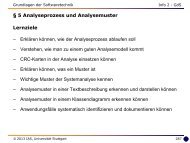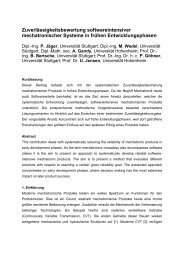Grundlagen FlexRay - Institut für Automatisierungs- und ...
Grundlagen FlexRay - Institut für Automatisierungs- und ...
Grundlagen FlexRay - Institut für Automatisierungs- und ...
Create successful ePaper yourself
Turn your PDF publications into a flip-book with our unique Google optimized e-Paper software.
<strong>Gr<strong>und</strong>lagen</strong> <strong>FlexRay</strong> BasicsV 1.1 20<br />
2.5 Signal transmission<br />
<strong>FlexRay</strong> uses two twisted wires for transmitting signal data. The transmission uses differential<br />
voltage levels aro<strong>und</strong> 2.5V. The transmit level uBus results out of the difference between uBP<br />
and uBM.<br />
Figure 2.14 <strong>FlexRay</strong> level diagram [FREPLS06]<br />
Using the different levels shown in Figure 2.14, the <strong>FlexRay</strong> bus can have four different<br />
states:<br />
• Idle_LP (Idle Low Power) – the level uBus is 0 V, and transceivers pull the voltage<br />
level of the <strong>FlexRay</strong> bus to GND.<br />
• Idle – the level uBus is 0 V, uBP and uBM are 2.5 V<br />
• Data_0 – the level uBus is -2 V, since at least one <strong>FlexRay</strong> transceiver has set Bus<br />
Plus to 1.5 V and Bus Minus to 3.5 V.<br />
• Data_1 – the level uBus is -2 V, since at least one <strong>FlexRay</strong> transceiver has set Bus<br />
Plus to 3.5 V and Bus Minus to 1.5 V.<br />
The bus states Idle, Data_0 and Data_1 are detected by the Bus Drivers in normal mode of<br />
operation, and have different values, depending on their position in the network. These Test<br />
Points (TP) are defined in Figure 2.15, and Table 2.1 shows the valid levels of uBus.<br />
Additionally, Figure 2.16 shows the timing of the falling and rising edges and the signal<br />
duration.<br />
Bäurle 12.10.2012
















